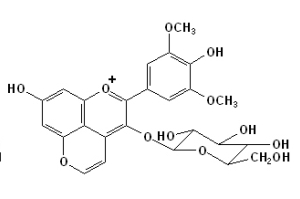Derived wine pigments created from grape anthocyanins and reactions with fermentation and oxidation products. Jenn Angelosante 2015
Color is an important sensory component of red wine that has been shown to influence consumer preference. Pyranoanthocyanins are anthocyanin derived red wine pigments, that were discovered relatively recently (the first example was isolated in 1996), and have gained attention owing to their contribution to wine color and relative stability compared with anthocyanins (Rentzsch et al. 2007a). They are characterized by a new pyran ring at the 4 carbon and 5 hydroxyl positions on the anthocyanin due to the addition of compounds including hydroxycinnamates, fermentation products like pyruvate and acetaldehyde, vinylflavanols, and vitisins (Figure 1). Their color contribution is distinct from that of anthocyanins, with most compounds exhibiting a red-orange in color that is believed to contribute to the brick-red hue observed in aged wine. One class (portisins) is blue in color. Unlike anthocyanins, pyranoanthocyanin color is not bleached by bisulfite or by high wine pH (De Freitas and Mateus 2011). Notable examples include vitisin A, vitisin B, and pinotin A, which have pyruvate, acetaldehyde, and vinyl phenol precursors, respectively.
Few studies address the concentration of pyranoanthocyanins in wine, owing to the fact that so many derivatives are involved and a lack of pure standards. Additionally, it is anticipated that a large number of pyranoanthocyanin derivatives and polymers have not yet been identified. Research has indicated that individual pyranoanthocyanins are present at ppm levels (Rentzsch et al. 2010; Schwarz et al. 2004; Mateus and de Freitas 2001; Schwarz et al. 2003; Rentzsch et al. 2007b; Marquez et al. 2012). There are three important factors affecting the formation of pyranoanthocyanins: presence of anthocyanin, presence of a partner for the anthocyanins, and time (Rentzsch et al. 2007a). In general, pyranoanthocyanin formation occurs when respective precursors appear, either during fermentation, or later during aging and coincides with the disappearance of anthocyanins, which is most significant over the first couple years of wine aging. Winemaking processes that increase the concentration of pyranoanthocyanin precursors have been shown to increase pyranoanthocyanin concentration in wine. Selection of yeast strains that produce more acetaldehyde and pyruvate results in higher vitisin concentration (Morata et al. 2003). Malolactic fermentation (MLF) results in depletion of acetaldehyde and pyruvate by microbes, and delaying MLF increases the concentration of vitisins (Burns and Osborne 2014). Winemaking maceration techniques that increase the concentration of flavanols and anthocyanins have also been shown to increase the amount of pyranoanthocyanins (Rentzsch et al. 2007b). More research is necessary to understand the extent to which pyranoanthocyanins impact red wine color and the winemaking decisions that impact their concentration.

Figure 1. General structure of pyranoanthocyanin.
References
Burns, T. R. and J. P. Osborne. 2014. Loss of Pinot noir wine color and polymeric pigment after malolactic fermentation and potential causes. Am. J. Enol. Vitic. Published ahead of print doi: 10.5344/ajev.2014.14061.
De Freitas, V. and N. Mateus. 2011. Formation of pyranoanthocyanins in red wines: a new and diverse class of anthocyanin derivatives. Anal. Bioanal. Chem. 401:1463-1473.
Marquez, A., M. Duenas, M.P. Serratosa, and J. Merida. 2012. Formation of vitisins and anthocyanin-flavanol adducts during red grape drying. J. Agric. Food Chem. 60:6806-6874.
Mateus, N., and de Freitas, V. 2001. Evolution and stability of anthocyanin-derived pigments during port wine aging. J. Agric. Food Chem. 49:5217–5222.
Morata, A., M. Gomez-Cordoves, B. Colomo, J. Suarez. 2003. Pyruvic acid and acetaldehyde production by different strains of Saccharomyces cerevisiae: relationship with vitisin A and B formation in red wines. J. Agric. Food Chem. 51:7402-7409.
Rentzsch, M., M. Schwarz and P. Winterhalter. 2007a. Pyranoanthocyanins-an overview on structures, occurrence, and pathways of formation. Trends in Food Science & Technology. 18:526-534.
Rentzsch, M., Schwarz, M., Winterhalter, P., and Hermosín-Gutiérrez, I. 2007b. Formation of hydroxyphenyl-pyranoanthocyanins in Grenache wines: Precursor levels and evolution during aging. J. Agric. Food Chem. 55:4883–4888.
Rentzsch, M., M. Schwarz, P. Winterhalter, D. Blanco-Vega, and I. Hermosin-Gutierrez. 2010. Survey on the content of Vitisin A and hydroxylphenyl- proanthocyanins in Tempranillo wines. Food chemistry. 119:1426-1434.
Schwarz, M., P. Quast, D. Von Baer, and P. Winterhalter. 2003c. Vitisin A content in Chilean wines from Vitis vinifera Cv. Cabernet sauvignon and contribution to the color of aged red wines. J. Agric. Food Chem. 51:6261-6267.
Schwarz, M., Hofmann, G., and Winterhalter, P. 2004. Investigations on anthocyanins in wines from Vitis vinifera cv. Pinotage: Factors influencing the formation of pinotin A and its correlation with wine age. J. Agric. Food Chem. 52:498–504.
